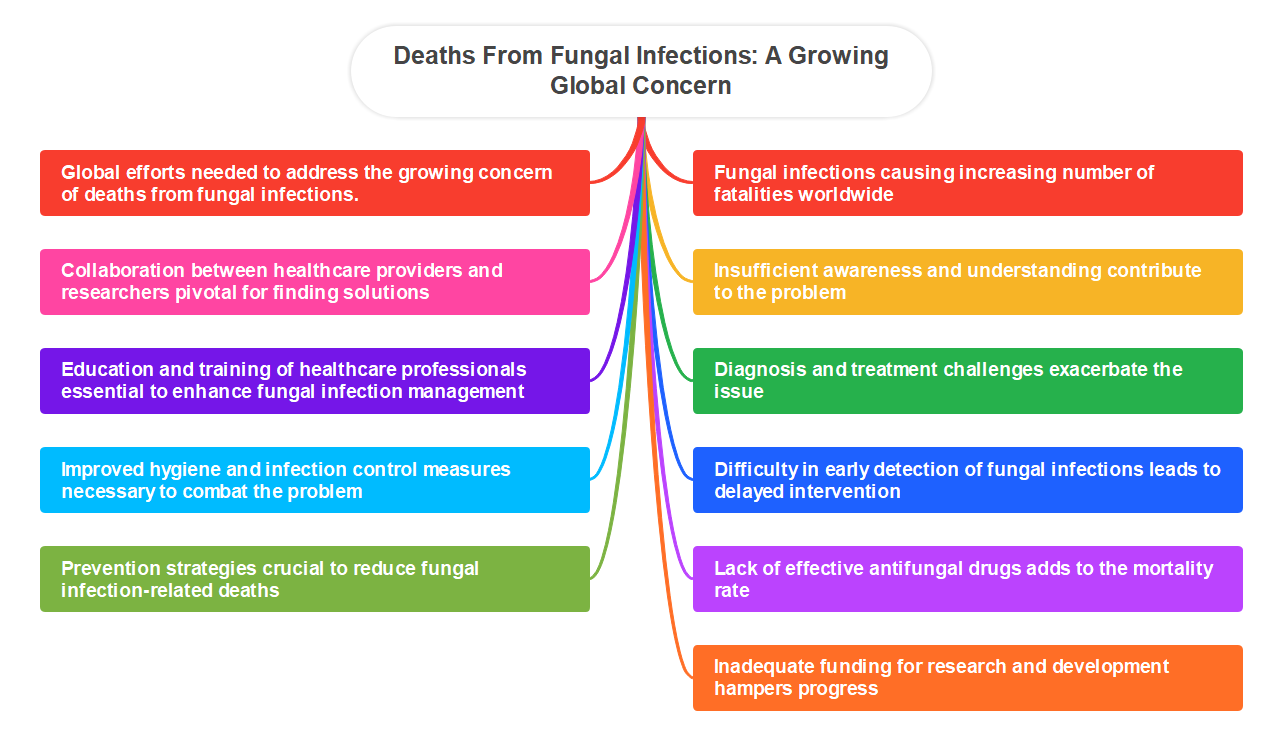Deaths From Fungal Infections: A Growing Global Concern
In the past decade, the number of deaths caused by fungal infections worldwide has doubled. This alarming increase raises concerns regarding the impact of these infections on global health. Fungal infections, often overlooked and underestimated, pose a significant threat to human life. In this article, we will explore the reasons behind the rising number of deaths from fungal infections, the challenges faced in diagnosing and treating these infections, and the urgent need for improved diagnostic tests and antifungal drugs.
The Alarming Reality: Rising Deaths from Fungal Infections
It is estimated that fungal infections now account for nearly 6.8% of total global deaths, with approximately 3.8 million individuals losing their lives to these infections annually. To put this into perspective, coronary heart disease is responsible for 16% of global deaths, followed by stroke at 11%. Smoke-related lung diseases account for 6% of total deaths, with fungal infections contributing to one-third of these cases.
Understanding the Challenges: Limited Access to Diagnostic Tests
Although there have been significant advancements in fungal disease diagnostics over the past decade, access to and usage of these tests remain limited, not only in low-income countries but also in some
developed nations. For example, South Africa has a commendable diagnostic service for certain fungal infections but lacks the necessary diagnostics for other common fungal infections. This lack of access to comprehensive diagnostics contributes to unnecessary deaths from fungal infections.
The Importance of Timely Diagnosis: Saving Lives
Timely diagnosis of severe fungal infections, such as Aspergillus infections, can save millions of lives each year. Unfortunately, many individuals do not receive a timely diagnosis due to their doctor’s failure to recognize fungal diseases. Moreover, slow or absent diagnostic testing contributes to delayed treatment, leading to increased mortality rates. Swift recognition and treatment of severe Aspergillus infections, ideally within 48 hours, could make a substantial difference in reducing fatalities.
Lethal Fungi and their Impact
Among the most lethal fungi responsible for causing lung infections are Aspergillus fumigatus and Aspergillus flavus. These infections primarily affect individuals with pre-existing lung diseases, such as asthma, tuberculosis, and lung cancer. Additionally, those who have undergone organ transplants or are in intensive care are also at a higher risk. Sadly, many of these individuals succumb to fungal infections due to delayed or missed diagnoses and a lack of effective antifungal drugs.
Antifungal Resistance: A Growing Concern
Similar to antibiotic resistance, antifungal resistance is becoming a significant challenge. The excessive use of certain fungicides in agriculture has contributed to a rise in resistance rates to azole antifungal drugs. This resistance poses a threat to the already limited arsenal of antifungal drugs available, further complicating treatment options. Urgent action is needed to address this growing problem and preserve the efficacy of available antifungal medications.
Candida Infections and their Devastating Consequences
Candida infections, found in the bloodstream, are responsible for sepsis and are often linked to diabetes, renal failure, major surgeries, or trauma. With over 1.5 million people globally affected by life-threatening Candida infections and nearly 1 million deaths annually, there is an urgent need for improved diagnostic tests. Currently, blood culture tests can only identify 40% of life-threatening Candida infections. Enhancing diagnostic capabilities is essential for early intervention and improved outcomes.
Fungal Infections and AIDS: A Deadly Combination
Fungal infections contribute significantly to the mortality rates of individuals living with AIDS. Approximately 50% of the estimated 600,000 deaths from AIDS are attributable to fungal infections. Eradicating cryptococcal meningitis as a cause of death is a key global effort led by organizations such as the US Centers for Disease Control and Prevention and the World Health Organization. Furthermore, more research is required to address the impact of histoplasmosis, often misdiagnosed as tuberculosis in Africa and southeast Asia, in individuals with AIDS.
COVID-19: Uncovering the Hidden Impact on Fungal Infections
The COVID-19 pandemic has shed light on the hidden impact of fungal infections. The world witnessed a large-scale outbreak of mucormycosis, commonly referred to as “black fungus,” in India during the pandemic. Excessive usage of steroids for COVID-19 treatment, coupled with uncontrolled diabetes, led to a significant increase in mucormycosis cases. Moreover, Aspergillus and Candida infections were more prevalent in COVID-19 patients in intensive care units worldwide. These startling findings were not fully considered in the recent incidence and mortality figures, suggesting that the actual numbers could be even higher.
The Double Whammy: Fungal Infections and Influenza
People admitted to intensive care with influenza face an increased risk of life-threatening Aspergillus infections. In fact, the presence of Aspergillus infection doubles the risk of death, even if the infection is diagnosed. Experts express concern about the possibility of a double whammy epidemic of fungal infections and influenza or another respiratory virus in the near future. This potential combination underscores the urgent need for effective preventive measures and improved diagnostics.
Fungal Allergy and the Impact on Asthma
Fungal allergies are closely linked to severe and poorly controlled asthma. As asthma becomes increasingly prevalent and problematic, individuals with fungal asthma require multiple medications and often experience flare-ups, emergency room visits, and hospitalizations. Despite significant efforts to control asthma, an estimated 461,000 individuals die from the condition each year or with asthma as a contributing factor to their final illness. It is crucial to recognize the association between fungal allergy and asthma and take appropriate measures to manage and treat these conditions.

Fungal infections pose a significant threat to global health and have led to a doubling of deaths worldwide in the past decade. The lack of access to comprehensive diagnostic tests, delayed diagnoses, and limited treatment options contribute to the rising mortality rates. Urgent action is needed to address these challenges, including the development of better diagnostic tests and the discovery of new antifungal drugs. Fungal infections are not going away, and their impact on human health cannot be ignored. Accurate and timely diagnosis is crucial in saving lives and effectively managing these infections.
Keywords: fungal infections, worldwide deaths, diagnostic tests, Aspergillus infections, antifungal resistance, Candida infections, AIDS and fungal infections, COVID-19 and fungal infections, respiratory viruses, fungal allergy, asthma.
Read Latest News on Precision Agriculture
- SEO Powered Content & PR Distribution. Get Amplified Today.
- PlatoData.Network Vertical Generative Ai. Empower Yourself. Access Here.
- PlatoAiStream. Web3 Intelligence. Knowledge Amplified. Access Here.
- PlatoESG. Carbon, CleanTech, Energy, Environment, Solar, Waste Management. Access Here.
- PlatoHealth. Biotech and Clinical Trials Intelligence. Access Here.
- Source: https://www.biotecnika.org/2024/01/fungal-infections-the-silent-killer-taking-millions-of-lives-worldwide/


